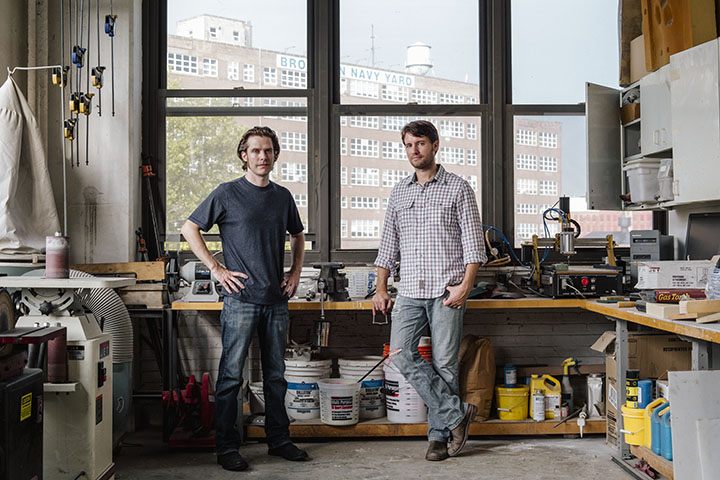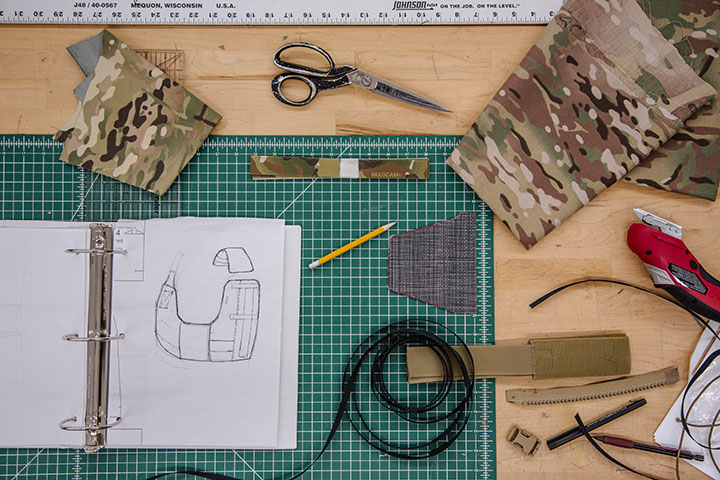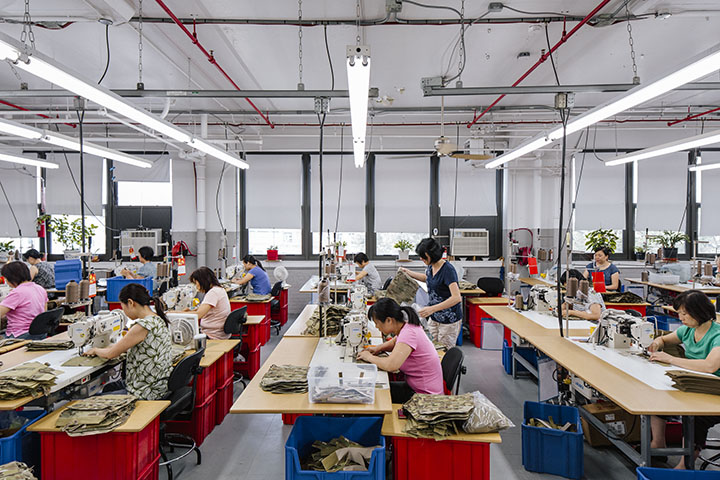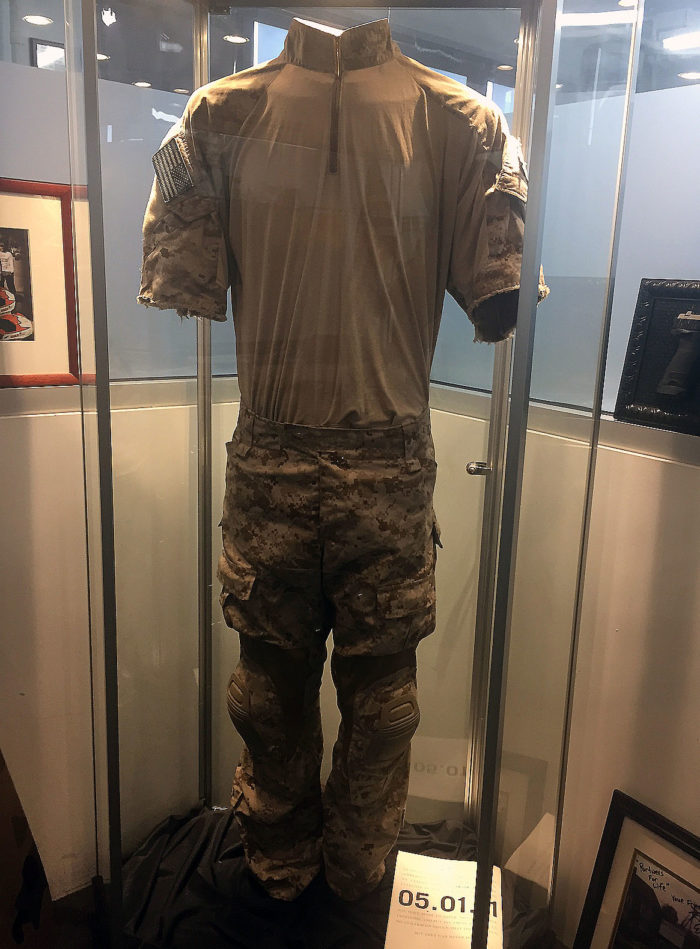On a tour of his shiny, new 90,000 sq. ft. design-and-production facility with soaring glass walls and a ceiling as high as an airplane hangar’s, Gregg Thompson picks up a tan helmet, a gift from a special-ops soldier. Thompson rubs his finger into a half-inch divot near where the wearer’s temple would be. “He got shot in the head,” Thompson said. “He didn’t even know it until he took his helmet off.”
The helmet was designed and manufactured by Crye Precision, the military-gear maker co-founded in 2000 by Thompson and college pal Caleb Crye. Another proud possession stands in a glass box in the corner of the same room: a tan military suit, made by their company, that was worn by a U.S. Navy Seal during the killing of Osama bin Laden. “It’s got some of Bin Laden’s blood on it,” Thompson said.
Crye Precision, based in the Brooklyn Navy Yard, makes helmets, body armor, uniforms and other gear for top U.S. military and police units as well as armed forces around the world. The company has been so innovative in meeting the needs of the troops, particularly the special operators, that Crye has been called “the Steve Jobs of tactical gear.” In the room featuring the combat mementos, the wall is lined with framed notes from American and British special-ops agencies, thanking the Brooklyn firm for all the top-notch gear.

Co-founders Caleb Crye and Gregg Thompson in 2014 at their headquarters in the Brooklyn Navy Yard
The partnership of Crye and Thompson is a blend of science and design, fostered by the school where they met, Cooper Union in Manhattan. Thompson was a 24-year-old getting his master’s degree in mechanical engineering, while Crye was an art student. Their first project together was a rugged, portable ballistic computer for aiming mortar fire, which never made it into the military’s supply line. Following that, the duo won a design competition for outfitting the soldier of the future, and their direction was set. Their first commission was an assignment to design a new combat helmet.
Why did they focus on the military, as opposed to the civilian market? “Because it would be rewarding and I actually like the military,” Crye said in an interview for Cooper Union’s website a few years ago. “I’m a huge fan of freedom and see our military as a big part of what safeguards that.”
The company’s emphasis on helmets and body armor came coincidentally as the U.S. was gearing up to send hundreds of thousands of troops to Afghanistan and Iraq in the aftermath of 9/11. In 2002, Crye moved from a workspace in Chelsea to a 1,000 sq. ft. space in the Navy Yard and has been expanding ever since. From 2007 to 2016, Crye Precision worked on 238 contracts worth $97 million for the U.S. government, producing gear for the departments of defense, justice, homeland security and state.

The entire process, from design to production, takes place in Crye’s facilities in the U.S.
Work started on the new space in 2016, and renovations have transformed the former hanger space to give it a space-age feel. The entryway features a lush zen garden lined with ferns, and the factory is dotted with airy rooms for workers to exercise, garden, cook and eat throughout the day.
Looking out over 12,600 boxes of gear stacked up and ready to ship, Thompson explains how his new HQ is vertically integrated, from the beginning of the production path to the end. Designers and engineers create prototypes; production workers cut metal, plastics and fabrics; rows of workers at sewing tables stitch the pieces together.
While the company employs 200 workers, it has invested in automation and advanced tools as well, including a conveyor-driven cutter (“I can cut as many pieces of fabric as I need,” Thompson says), a 3-D printer and machines with lasers and pressurized-water-shooters for welding and molding helmets and metal parts, Thompson said.

Dozens of workers at sewing tables in Brooklyn stitch the protective garments together
The privately held company holds nearly 30 patents, and 100 pieces of intellectual property, including copyrights and trademarks, Thompson said. Right now, the company is working on specialized clothing for undercover agents, so they can hide guns, wires and armor within shirts and light jackets. “They have to look normal,” Thompson says as he ruffles through some of the prototypes. Crye’s body armor, in particular, has won high marks for being concealable because it’s molded for a tight fit around the body. Other Crye products give protection against chemical weapons as well as shrapnel protection for faces, legs and groin areas.
The company is most famous for inventing MultiCam, a new design of camouflage, released in 2004, which works well in varied terrain but is highly effective in the desert. The previous camouflage hadn’t been updated since the Vietnam War era, Thompson said, and featured darker greens and browns to blend into the jungle. The old design stuck out in the sandy terrain of Iraq and Afghanistan.

This suit, made by Crye Precision, was worn by a Navy Seal in the raid that killed Osama bin Laden (Photo by Lisa M. Collins)
After Crye Precision manufactured MultiCam and patented the design, the secretive Delta Force, a special-ops unit of the U.S. Army, was the first to use it. U.S. Army Rangers, another elite unit, began to demand MultiCam when they saw how effective it was, Thompson said.
The Rangers then asked Crye Precision to redesign their combat helmet, which weighed nearly seven lbs. when special gear and night-vision goggles were connected to it. Crye Precision got to work, and reduced the weight of the helmet by 30%. “We’ve maintained a close relationship with those guys,” Thompson said. “If they need something, we’ll do it.”
MultiCam in 2010 became the standard for soldiers deployed to Afghanistan. Crye also redesigned the style of shirts and pants the soldiers would wear, to make them lighter, removing unneeded pockets, and to make the clothing more rugged, Thompson said.
Thompson said his company’s strong connection to its ultimate customers, the fighting forces, provides a lot of motivation to keep innovating on their behalf. “It’s very unlikely that we would have pursued this as long as we have, and as hard as we did, if it wasn’t for our customers,” Thompson said. “These are people with real needs. It’s really a purposeful thing to be able to do, purposeful and meaningful. We’re proud of getting guys what they want.”